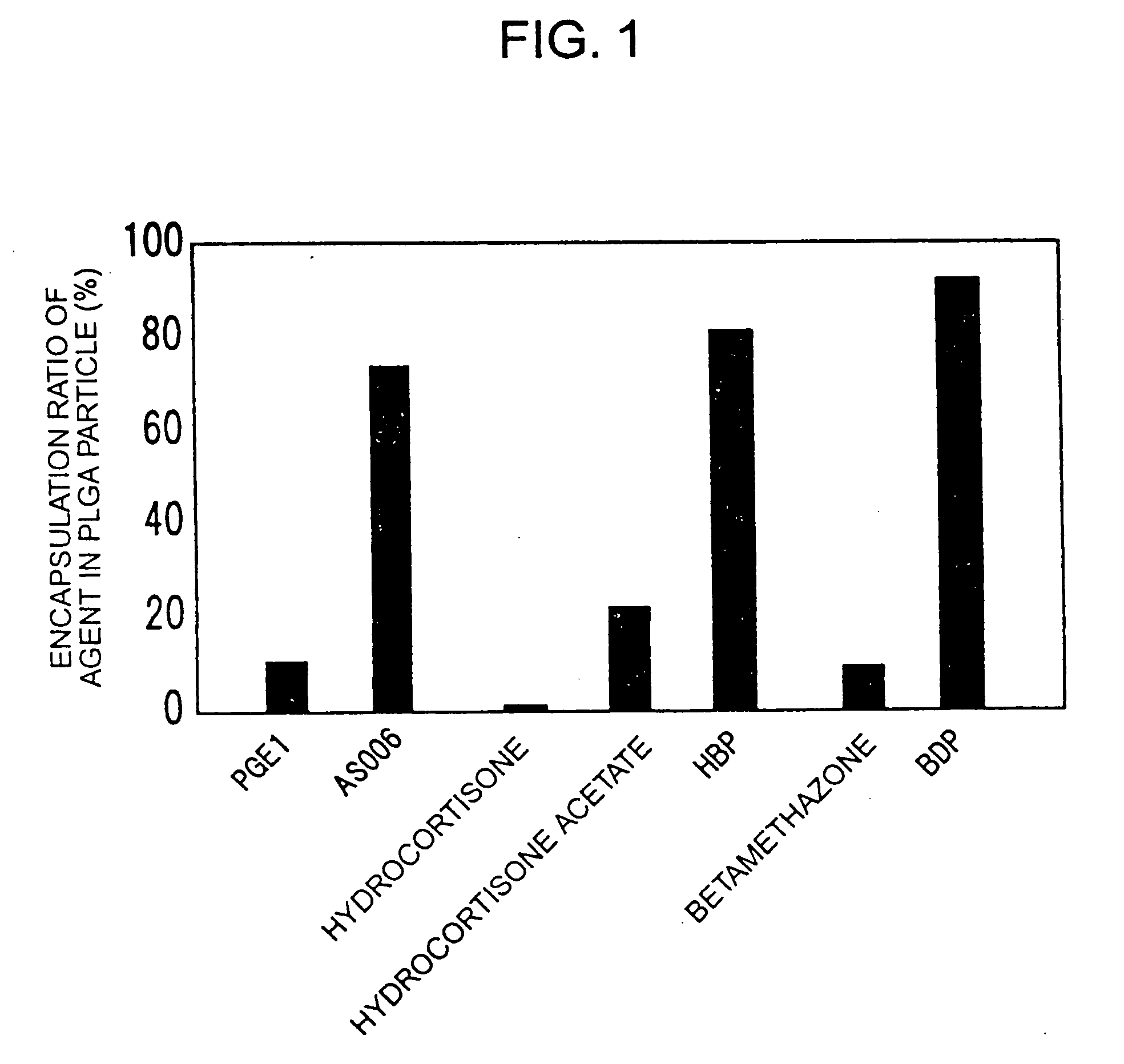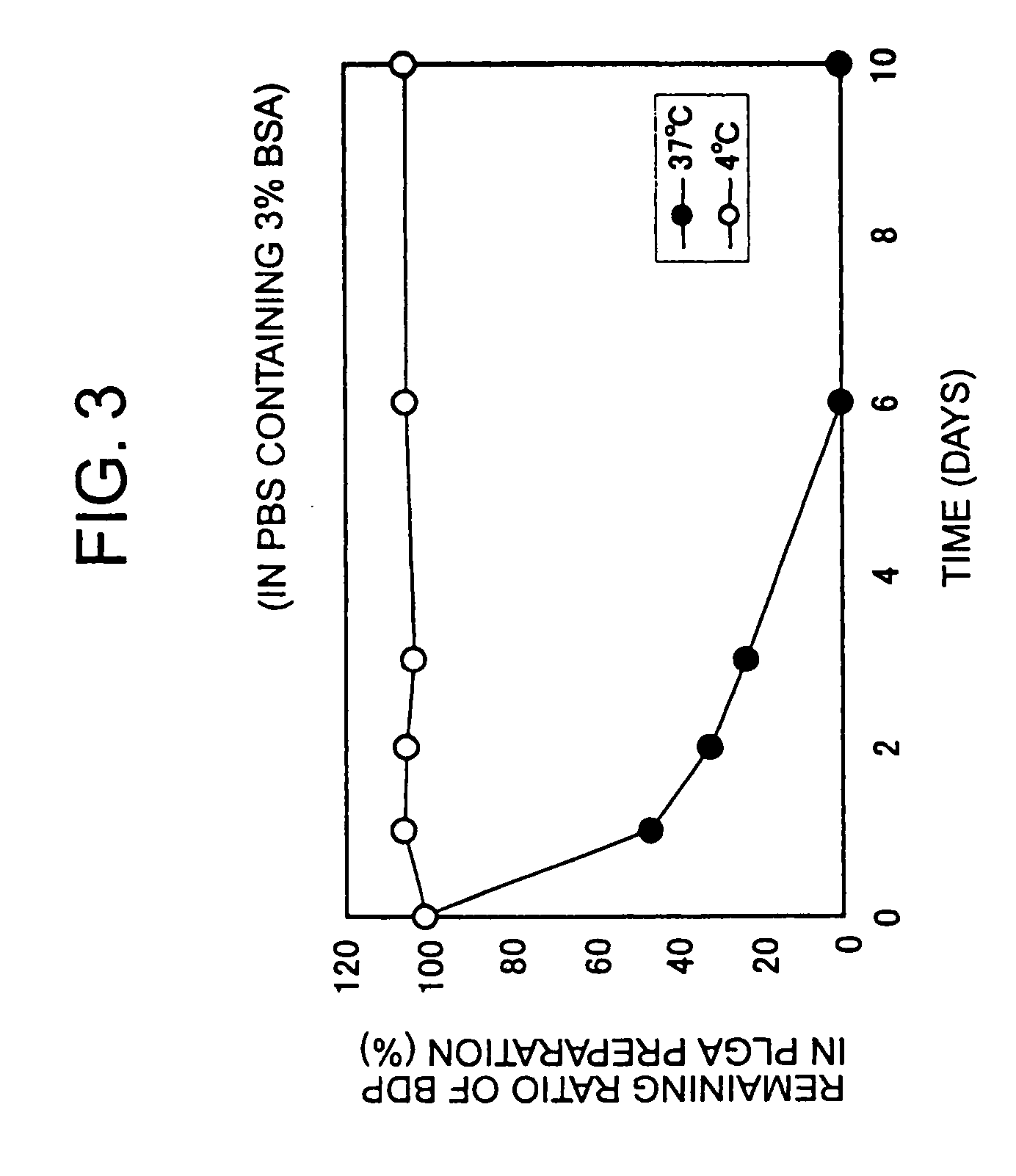Intravenous composition, process for producing the same and preparation thereof
a technology of composition and intravenous injection, which is applied in the direction of biocide, drug composition, and elcosanoid active ingredients, can solve the problems of inability to obtain the technique of encapsulating the aforementioned pge1 or pgi2 in plga and applying the obtained product to dds has also been problematic. achieve the effect of sufficient sustained release effects, excellent encapsulation ratio, and sustained release effects
- Summary
- Abstract
- Description
- Claims
- Application Information
AI Technical Summary
Benefits of technology
Problems solved by technology
Method used
Image
Examples
example 1
Production Method of PLGA / PLA Preparation
[0032] 100 mg of PLGA (Wako) or PLA (Wako), 10 mg of egg yolk lecithin, and 0.5 mg of an agent were dissolved in 1 ml of dichloromethane. While cooling in an ice bath, the obtained solution was slowly added dropwise, through a 27G needle, to 25 ml of distilled water, which was being stirred with Polytron PT-2100 (Kinematica) or an ultrasonic generator (TOMY). After the stirring was continued for 10 minutes, the mixture was further stirred with a stirrer at room temperature for 2 hours. Thereafter, dichloromethane was removed. The obtained microparticles were concentrated by ultra filtration (Amicon, Centriprep YM-10) and were then purified by gel filtration (Pharmacia, PD-10). The thus obtained particles were centrifuged at 13,000 g for 10 minutes, and the agent contained in the supernatant and deposit was assayed by HPLC. HPLC analysis was carried out in a water / acetonitrile system for measuring the absorption at 210 nm or 240 nm using a C4...
example 2
[0034] 30 mg of PLGA (Wako) or PLA (Wako), 3 mg of egg yolk lecithin (Wako), and 1 mg of AS006 or BDP were dissolved in 1 ml of dichloromethane, and microparticles were then produced by the same method as described in Example 1. The obtained microparticles were suspended in distilled water, PBS, or 3% BSA-containing PBS. The suspension was allowed for a certain period of time, and was then centrifuged at 13,000 g for 10 minutes. Thereafter, AS006 or BDP contained in the deposit was assayed by HPLC.
[0035] As shown in FIG. 2, as a result, it was found that AS006 was gradually released over 11 days in the water or PBS at 37° C., and that AS006 was released over 4 days in the 3% BSA-containing PBS at 37° C. Thus, it became clear that prostanoid was released from the microparticles.
[0036] In a case where the microparticles were incubated in water at 4° C., even after 10 days, almost no release of AS006 was observed. Further, in 3% BSA-containing PBS at 4° C., approximately 30% of the a...
example 3
[0038] Each of the agents produced in Example 1 was suspended in 80% FBS (fetal bovine serum) or in a 1% SDS aqueous solution, and the suspension was incubated at 37° C. for 5 minutes. Thereafter, the resultant product was centrifuged at 13,000 g for 10 minutes, and the amount of the agent contained in the deposit was assayed by HPLC.
[0039] As shown in FIG. 4, as a result, it was found that only 10% to 20% AS006 remained in the presence of 1% SDS or in 80% FBS. Although the production conditions such as the weight ratio of PLGA to AS006 were increased, the ratio of the distribution was not changed. Thus, it became clear that AS006 has a higher affinity to the lecithin layer than to the PLGA layer. Moreover, it was also found that the remaining ratio of AS006 is reduced in a BSA-concentration-dependent manner. On the other hand, in the case of BDP as a steroid derivative or other agents, 80% or more agents remained in PLGA even with the addition of SDS, and thus, it became clear tha...
PUM
| Property | Measurement | Unit |
|---|---|---|
| Diameter | aaaaa | aaaaa |
| Diameter | aaaaa | aaaaa |
| Ratio | aaaaa | aaaaa |
Abstract
Description
Claims
Application Information
 Login to View More
Login to View More - R&D
- Intellectual Property
- Life Sciences
- Materials
- Tech Scout
- Unparalleled Data Quality
- Higher Quality Content
- 60% Fewer Hallucinations
Browse by: Latest US Patents, China's latest patents, Technical Efficacy Thesaurus, Application Domain, Technology Topic, Popular Technical Reports.
© 2025 PatSnap. All rights reserved.Legal|Privacy policy|Modern Slavery Act Transparency Statement|Sitemap|About US| Contact US: help@patsnap.com



